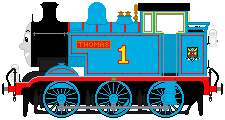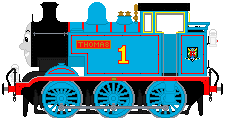HOME | DD
 Curtis-Parish — Thomas The Tank Engine sprite (my design)
Curtis-Parish — Thomas The Tank Engine sprite (my design)

#engine #tank #thomas #ttte #thomasthetankengine #thomas_the_tank_engine
Published: 2019-04-16 18:45:23 +0000 UTC; Views: 9408; Favourites: 44; Downloads: 18
Redirect to original
Description
I made a sprite of Thomas The Tank Engine in my design.My design is in the mixture of The Railway Series and the television series. Thomas' sprite face is in the style of Reginald Payne/C. Reginald Dalby. Thomas' wheel arch is a sandbox in which I got the inspiration from 's design of Thomas' toolbox wheel arch.
Sign the petition to get Thomas And The Magic Railroad Director's Cut released. The petition needs 10,000 signatures by May 1st.
restorethemagic.org/index.php/…
For , , , , , , and .
Details by (Me).
Free to use. Give credit for it, please.
All rights belong to Mattel Creations.
Related content
Comments: 4

👍: 0 ⏩: 0

THE series of railway stories written by the Rev. W. Awdry and published by Edmund Ward, Leicester, will no doubt be familiar at least to those readers with young children. Having been commissioned by the publisher to produce models of the locomotives featured in these books, it occurs to me that photographs of the results might interest, and perhaps amuse, readers. After all, although every railway enthusiast knows that the steam locomotive is the most "human" of all machines, it is not every day that one finds oneself modelling locomotives of, shall we say, such "expressive" aspect as those illustrated.
The models are to 7mm. scale and are non-powered, although provision is made for the fitting of motors at a later date if required. Scale elevations had first to be prepared from the artist's illustrations, and this presented some difficulty in capturing the "character" of each engine. However, before we go any further let me introduce you to the individual members of this — unusually — happy locomotive family.
No. 1 "Thomas" is a 0-6-0 tank loco. who attained the dignity of his own branch-line and train. Although he is based in no particular prototype, his air of bustling self-importance with more than a dash of impudence is surely typical of dozens of actual small tank locos to be found conducting their important affairs on country branches up and down the Kingdom.
No. 2 "Edward" is an example of that classic "maid-of-all-work" of British railway practice, the inside-cylinder 4-4-0. I always have a feeling that this type of engine is the most benign of all locomotive classes, and I am delighted to find that the Rev. W. Awdry shares my opinion, for "Edward" is the most good-tempered of the "family."
No. 3 "Henry" has recently been completely rebuilt; he previously had a very shallow fire-box, and present-day coal (so-called) had an unfortunate effect on his "internal workings." In his new form, he bears a striking resemblance to the Stanier Class 5 4-6-0 design of immediate "pre-Nationalisation" days. "Henry" shares express duties with:
No. 4 "Gordon" who is the aristocrat of the locomotive stud and does not let the other engines forget it. He closely resembles an L.N.E.R. A3 Pacific.
No. 5 "James" is an old-fashioned 2-6-0 (based actually on a G. & S.W.R. prototype). Although most of his time is spent on secondary duties, there have been glorious occasions where he has hauled "Gordon's" express. The engine with which, in Photo 4, he appears to be sharing a private joke, is:
No. 6 "Percy", an 0-4-0 saddle-tank. In suggesting the basic design for this engine, an effort was made to "capture" the authentic character of the small "industrial" shunter. "Percy", as you will gather, is as cheeky an imp of a locomotive as ever ran on rails and a constant irritant to the other locomotives.
It should be noted that, where an actual prototype is used as the basis for one of the designs, the characteristics of the original have been to some extent "exaggerated" by the illustrator to suit his particular purposes.
The main frames of each loco, are cut from 1/16 in. nickel-silver, two "blanks" being soldered together for drilling all holes and shaping to outline. Frames are then bolted together with with countersunk 6 B.A. bolts screwed into frame spacers specially turned from brass and threaded internally. Cross-stretchers are then soldered in where needed to carry bogey-pivot, footplate fixings and other attachments. Driving-axle bearings are slotted out downwards and the axles retained in place by keeper strips bolted on below, so that the complete set of driving wheels can be "dropped" as a unit when required. Bogies and pony trucks are bolted and soldered up from strip brass and nickel-silver and are pivoted on the "radial-arm" principle with a weight-bearing spring rubbing on a stretcher approximately above the bogie centre.
Below the footplates, in fact, construction follows more or less orthodox lines, with metal the predominating material. But above the footplates, I have followed my usual practice of using whatever material seems likely to give the best effect with the greatest facility of construction, and the superstructures are largely non-metallic; although no one could guess this from the finished and painted appearance. Footplates, for instance, are of hard fibre sheet, the correct thickness for the edge to form the valance depth. This causes almost no loss in appearance over the correct "angle-edged plate" while giving a very strong and neat job. Where the ends drop at an angle separate pieces are joined on, but where they are curved the plate is bent after soaking in hot water. "Gordon's" reverse-curved footplate called for many soakings before the correct curve was achieved as the fibre very quickly hardens again, but it has the great advantage that, when it has hardened, it will keep to the shape produced when wet.
All superstructures from footplate up are removable. In the earlier models they are fixed down by to bolts in the cab floor and two through the front buffer-beam, but in the last two models the front bolts are dispensed with. In the case of "Henry", two fixed pegs in the vertical section of the front footplate "drop" engage holes in a frame-stretcher. In "Gordon" the section of the footplate ahead of the cylinders is mounted permanently on the frames (the joint being just ahead of the steam-pipes) and a wood block mounted below the removable section and fitting between the frames engages under the fixed footplate (Fig. 1).
Boilers are made by rolling layers of Bristol board on a wood former of suitable diameter. the layers are glued together and each boiler shell consists of three or four layers. When wood "bulkhead" discs have been fitted and the boiler treated with shellac varnish it has great strength and rigidity. "Henry" and "Gordon" have taper boilers made as shown in Fig. 2. A parallel tube was first made, rather smaller than the smallest boiler diameter, on the smokebox end of which other layers were rolled on to make up the correct diameter for this section. A second tube was then rolled on to the first, to the smallest boiler diameter, but without gluing it to the first tube. when partially set, but before the glue had hardened too far, this second tube was slid off, slit down the bottom, and glued in place on the first tube with a shaped wood former to keep it at the correct diameter for the larger end.
Cabs are built up from 1/16 in. fibre sheet with celluloid windows. All the locos. have dummy cab fittings.
The "faces", which occupy the position where more conventional locomotives habitually keep their smokebox doors, are modelled in "Plastone", a form of Plasticine which hardens when exposed to the air. Unfortunately, it shrinks very considerably in setting so cannot be used for modelling on a solid "core" or serious cracking will occur. For uses like the present one, however, where parts can be moulded separately and allowance made for shrinkage, it is quite a useful medium.
Altogether, these models have provided one of those out-of-the-ordinary commissions which help to enliven the professional model-maker's life.
👍: 0 ⏩: 0



























